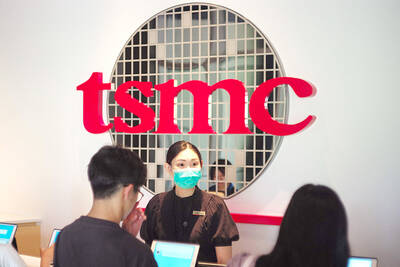China’s export growth unexpectedly picked up speed last month, offering an encouraging boost to the economy as its struggles to recover from a slump induced by the COVID-19 pandemic, but weakening global demand could start to drag on shipments in coming months.
Exports grew 18.0 percent from a year earlier, the fastest pace this year, Chinese General Administration of Customs data showed yesterday, compared with a 17.9 percent rise in June and beating analysts’ expectations for a 15.0 percent gain.
“China’s export growth surprised again on the upside. [It] continues to help China’s economy in a difficult year, as domestic demand remains sluggish,” Pinpoint Asset Management Ltd (保銀私募基金管理) chief economist Zhiwei Zhang (張智威) said.

Photo by AFP
Last month’s exports might also have been buoyed by pent-up demand from Southeast Asia as supply snarls eased and factories there ramped up production, Jones Lang Lasalle Inc chief economist Bruce Pang (龐溟) said in a research note.
Moreover, amid surging inflation, some European and US customers might have frontloaded orders heading into the holiday season to ensure they had goods on hand, he added.
However, many analysts have expected shipments to fade amid cooling global consumption.
While export growth remained high, mainly backed by price factors, the volume of exported goods dropped last month, Zhixin Investment Research Institute (植信投資研究院) senior analyst Chang Ran (常冉) said.
“Looking ahead in the second half of the year, exports are expected to be resilient in the short run, but weakening external demand may pressure them in the fourth quarter,” Chang said.
After a shaky second quarter, most analysts have expected China’s import momentum to pick up modestly in the latter half of the year, supported by construction-related equipment and commodities as the government ramps up infrastructure spending.
However, imports last month were again weaker than expected, suggesting domestic demand remains soft.
Imports rose 2.3 percent from a year earlier, compared with June’s 1 percent gain and missing a forecast of a 3.7 percent rise.
“Despite an uptick in domestic demand amid loosening COVID control measures, the weak performance of the production side dragged on imports,” said Xu Shuzheng, a researcher at CITIC Securities Co (中信證券), adding that fresh COVID-19 flare-ups could hinder the economy’s recovery.
Crude oil imports last month fell 9.5 percent from a year earlier, as fuel demand recovered more slowly than expected due to virus outbreaks.
The volume of imported integrated circuits — a major Chinese import — also dropped 19.6 percent last month from a year earlier, Reuters’ calculations showed.
That could be an additional red flag for exports, as a significant amount of the country’s imports are components for goods that are then re-exported.
China posted a record US$101.26 billion trade surplus last month, well above the US$90.0 billion surplus analysts had expected.

Taiwan Transport and Storage Corp (TTS, 台灣通運倉儲) yesterday unveiled its first electric tractor unit — manufactured by Volvo Trucks — in a ceremony in Taipei, and said the unit would soon be used to transport cement produced by Taiwan Cement Corp (TCC, 台灣水泥). Both TTS and TCC belong to TCC International Holdings Ltd (台泥國際集團). With the electric tractor unit, the Taipei-based cement firm would become the first in Taiwan to use electric vehicles to transport construction materials. TTS chairman Koo Kung-yi (辜公怡), Volvo Trucks vice president of sales and marketing Johan Selven, TCC president Roman Cheng (程耀輝) and Taikoo Motors Group

Among the rows of vibrators, rubber torsos and leather harnesses at a Chinese sex toys exhibition in Shanghai this weekend, the beginnings of an artificial intelligence (AI)-driven shift in the industry quietly pulsed. China manufactures about 70 percent of the world’s sex toys, most of it the “hardware” on display at the fair — whether that be technicolor tentacled dildos or hyper-realistic personalized silicone dolls. Yet smart toys have been rising in popularity for some time. Many major European and US brands already offer tech-enhanced products that can enable long-distance love, monitor well-being and even bring people one step closer to

New apartments in Taiwan’s major cities are getting smaller, while old apartments are increasingly occupied by older people, many of whom live alone, government data showed. The phenomenon has to do with sharpening unaffordable property prices and an aging population, property brokers said. Apartments with one bedroom that are two years old or older have gained a noticeable presence in the nation’s six special municipalities as well as Hsinchu county and city in the past five years, Evertrust Rehouse Co (永慶房產集團) found, citing data from the government’s real-price transaction platform. In Taipei, apartments with one bedroom accounted for 19 percent of deals last

RECORD-BREAKING: TSMC’s net profit last quarter beat market expectations by expanding 8.9% and it was the best first-quarter profit in the chipmaker’s history Taiwan Semiconductor Manufacturing Co (TSMC, 台積電), which counts Nvidia Corp as a key customer, yesterday said that artificial intelligence (AI) server chip revenue is set to more than double this year from last year amid rising demand. The chipmaker expects the growth momentum to continue in the next five years with an annual compound growth rate of 50 percent, TSMC chief executive officer C.C. Wei (魏哲家) told investors yesterday. By 2028, AI chips’ contribution to revenue would climb to about 20 percent from a percentage in the low teens, Wei said. “Almost all the AI innovators are working with TSMC to address the